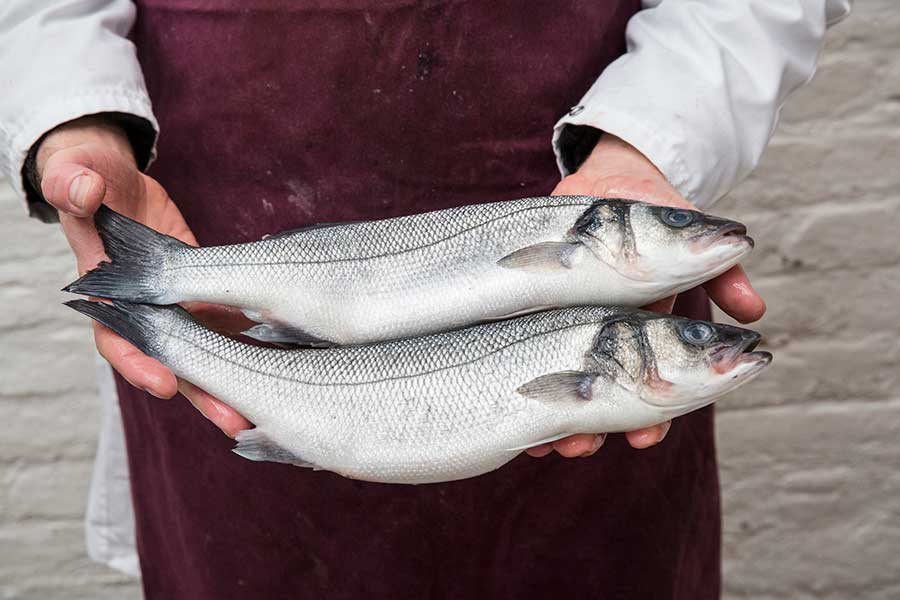Ask an Expert: 5 Things You Should Know When Buying Seafood
Fishtown Seafood's Bryan Szeliga busts common myths about "fresh fish" and gives us tips on how buy high-quality seafood like a pro.

Tips for buying seafood in Philly / Photograph by Mint Images via Getty Images
Navigating the seafood case at your local grocery store or seafood supplier can be a daunting task. How do you know if the fish is fresh? Does it matter that it’s been frozen? What questions should you ask your fishmonger?
Bryan Szeliga, owner of Fishtown Seafood, a thoughtfully sourced seafood shop in Fishtown, is known around the neighborhood for his encyclopedic knowledge of traceable seafood and helping Philadelphians learn where their fish is really from. With a second Fishtown Seafood opening in Fitler Square in mid-December (around 22nd and Pine), he wants to bust common myths about the seafood supply chain and change the way Philadelphians buy seafood. Szeliga says there are a few keys to remember when buying fish.
Consider what “fresh” really means
Szeliga reminds consumers that living by an ocean doesn’t always mean you will get fresh seafood straight out of the water, and buying from the fresh counter doesn’t mean your fish will be fresh. Szeliga uses an impedance monitor in his shop that tests fattiness of fish, overall freshness, and whether the fish has been previously thawed.
To better understand how an impedance monitor works, we put it to the test by purchasing four of the same salmon species from fresh fish grocery store counters across Philadelphia. The impedance monitor readings suggested that two of the salmon species from the test fish was thawed twice before it was sold. One of the salmon filets from the mid-range grocery store counter was already noticeably rancid based on the smell and a clear tacky film, and gaping flesh on the fish filet. “There are millions of people who buy smelly seafood every day, ” says Szeliga, who adds that fresh fish should have a mild flavor and no odor.
Takeo Kimura, founder of Assurant Innovations, a distributor of the impedance monitors in the United States says that in the seafood industry, there are strict guidelines to label something fresh. “It means that the fish or any seafood cannot be frozen. What many seafood companies do is to distort that a certain fish has never been frozen, passing it as “fresh.” says Kimura.

Brian Szeliga using an impedance monitor to test the quality of the fish. / Photograph by I&Cimageworks
Frozen fish is still pretty fresh
You might assume that fish labeled as “fresh” is always better, but Szeliga says that frozen is often great quality. “We don’t use the word ‘fresh.’ We would use the word ‘chilled’ if it’s above 32°F, frozen if it’s below 32°F, and super frozen if it’s below -76°F,” says Szeliga, who adds that retailers should be transparent about fish being previously frozen.
At Fishtown Seafood, he stocks mostly frozen fish, except for a few salmon, fresh oysters and clams. Each product is labeled based on how far the fish has traveled and whether it has arrived by truck or plane. “Frozen fish can be fresher than fresh fish because it can be processed and frozen at the time of capture, as freezer technology is now very efficient,” says Joe Lasprogata, vice president, of product development at Samuels and Son Seafood Company. “Many of the products are frozen pre-rigor, which can ensure the quality.”
Know the right questions to ask your seafood seller
Szeliga says not to ask the fish counter “What is fresh?” but, “When was this harvested?” since not all seafood is harvested on a daily basis. The harvest day may be different than the import day. “Let’s say a Canadian brand is harvesting their oysters once a week and it is on a Friday. That product will arrive in Boston on Saturday or Sunday. And be on a wholesale oyster shipper price list on Sunday to ship out of Boston on Monday for Tuesday arrival in Philly,” explains Szeliga. He says before they begin selling the newly arrived product, they need to sell any inventory of that brand from the previous week. That means that it could be several days or up to a week since the seafood was harvested, which can impact its freshness.
He also encourages consumers to ask their fishmonger: “Was this adulterated with chemicals like sodium tripolyphosphate or other salt?” Tripolyphosphate is a preservative that makes seafood appear fresher and firmer, and any added salt will help preserve the fish. “If 20 percent of a bag of shrimp is added moisture, the consumer ends up paying five dollars of the total cost of the bag of shrimp for water,” says Szeliga.
You can also ask your seller if the fish is thawed and how long it has been at the counter, which can help you make decisions about how soon it needs to be used or if it can be frozen again.
Understand seafood labeling
Szeliga says interpreting labels is a challenge and he’s committed to maintaining transparency about labeling in the industry. He says looking for third-party certification — like Marine Stewardship Council (MSC), Aquaculture Stewardship Council (ASC), or Best Aquaculture Practices (BAP) — is helpful because it maintains a standardization in seafood and focuses on responsible and ethical seafood farming and fishing.
“I have customers who walk into the shop and ask if [we] have wild-caught fish, and they will say that farm-raised fish is bad.” Szeliga counters that the “farm-raised versus wild-caught” fish discussion is complicated, and we have to change the perception that one fish is better than the other. He says it should be a low consideration for shoppers, and there are challenges with both types of fish because of labor issues, bycatch of other animal species, and chemical additives. Szeliga says you should ask these questions: “If it’s farmed: Was it raised with or without antibiotics, how far did it travel, and is it treated with chemicals? If it’s wild caught: Is there a domestic alternative to the fish and is it treated with chemicals?” At Fishtown Seafood, Szeliga provides the Food and Agricultural Organization names of fish, common name, market name of fish, and the Latin name of the fish so people can know exactly what species of fishing they are getting.
If you can, splurge on the more expensive fish – it’s worth it
Cost is certainly a factor when buying premium fish, but if you’re making fish for a special occasion, or can spring for the costlier filet, Szeglia says it’s worth it. Less expensive fish is likely going to have more additives, making the overall seafood experience less enjoyable. But being a savvy seafood consumer can be as simple as examining the ingredient list: The first ingredient should be seafood or fish, not salt or additives.
Looking for a place to buy your next fish dinner? Here are the best seafood shops in Philadelphia!


